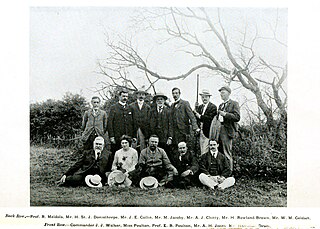
The superfamily Papilionoidea contains all the butterflies except for the moth-like Hedyloidea.

Lycaenidae is the second-largest family of butterflies, with over 6,000 species worldwide, whose members are also called gossamer-winged butterflies. They constitute about 30% of the known butterfly species.

Riodinidae is the family of metalmark butterflies. The common name "metalmarks" refers to the small, metallic-looking spots commonly found on their wings. The 1532 species are placed in 146 genera. Although mostly Neotropical in distribution, the family is also represented both in the Nearctic, Palearctic, Australasian (Dicallaneura), Afrotropic, and Indomalayan realms.

The Nymphalinae are a subfamily of brush-footed butterflies. Sometimes, the subfamilies Limenitidinae, and Biblidinae are included here as subordinate tribe(s), while the tribe Melitaeini is occasionally regarded as a distinct subfamily.

The chalkhill blue is a butterfly in the family Lycaenidae. It is a small butterfly that can be found throughout the Palearctic realm, where it occurs primarily in grasslands rich in chalk. Males have a pale blue colour, while females are dark brown. Both have chequered fringes around their wings.

Miletinae is a subfamily of the family Lycaenidae of butterflies, commonly called harvesters and woolly legs, and virtually unique among butterflies in having predatory larvae. Miletinae are entirely aphytophagous. The ecology of the Miletinae is little understood, but adults and larvae live in association with ants, and most known species feed on Hemiptera, though some, like Liphyra, feed on the ants themselves. The butterflies, ants, and hemipterans, in some cases, seem to have complex symbiotic relationships benefiting all.

Poritiinae is a subfamily of butterflies, the larvae of which are unusual for feeding on algae and foliate lichen.

Polyommatinae, the blues, are a diverse subfamily of gossamer-winged butterflies.
Butterfly evolution is the origin and diversification of butterflies through geologic time and over a large portion of the Earth's surface. The earliest known butterfly fossils are from the mid Eocene epoch, between 40-50 million years ago. Their development is closely linked to the evolution of flowering plants, since both adult butterflies and caterpillars feed on flowering plants. Of the 220,000 species of Lepidoptera, about 45,000 species are butterflies, which probably evolved from moths. Butterflies are found throughout the world, except in Antarctica, and are especially numerous in the tropics; they fall into eight different families.
George Thomas Bethune-Baker was an English entomologist who specialised in Lepidoptera, especially those in the family Lycaenidae of butterflies.

Zizeeria knysna, the dark grass blue or African grass blue, is a species of blue butterfly (Lycaenidae) found in Africa, on Cyprus and the Iberian Peninsula.

Ornipholidotos is a genus of butterflies, commonly called glasswings or white mimics, in the family Lycaenidae. The species of this genus are endemic to the Afrotropical realm.

Hamilton Herbert Charles James Druce was an English entomologist who specialised in Lycaenidae and to a lesser extent Hesperiidae. He is not to be confused with his father, the English entomologist Herbert Druce (1846–1913) who also worked on Lepidoptera.
Torbenia is a genus of butterflies, commonly called Zulus, in the family Lycaenidae. They are endemic to the Afrotropical realm. The five species were formerly placed in Ornipholidotos. The genus is named after Torben Bjørn Larsen.
Torbenia larseni, the Larsen's glasswing, is a butterfly in the family Lycaenidae. It is found in southern Nigeria and western Cameroon. The habitat consists of forests. The species was named after Torben Bjørn Larsen.
Torbenia wojtusiaki, the Wojtusiak's glasswing, is a butterfly in the family Lycaenidae. It is found in Ivory Coast, Ghana and western Nigeria. The habitat consists of forests.
Torbenia aurivilliusi is a butterfly in the family Lycaenidae. It is found in Cameroon, Equatorial Guinea, Gabon and the Republic of the Congo. The habitat consists of forests.
Torbenia stempfferi is a butterfly in the family Lycaenidae. It is found in Cameroon, the Republic of the Congo and the Democratic Republic of the Congo.
Henri Stempffer was a French entomologist who specialized in the study of Lycaenidae butterflies.










